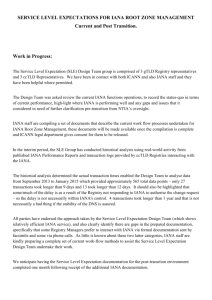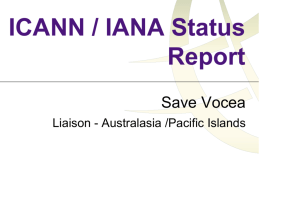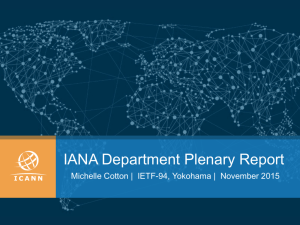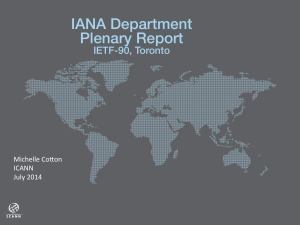Another look at that BGP data - Labs
advertisement
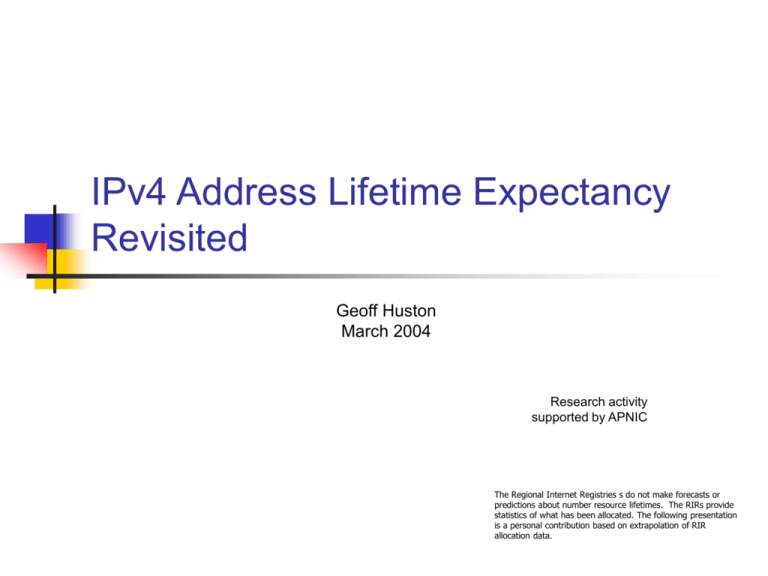
IPv4 Address Lifetime Expectancy Revisited Geoff Huston March 2004 Research activity supported by APNIC The Regional Internet Registries s do not make forecasts or predictions about number resource lifetimes. The RIRs provide statistics of what has been allocated. The following presentation is a personal contribution based on extrapolation of RIR allocation data. IPv4 Address Lifetime Expectancy This was an IETF activity starting as part of the Routing and Addressing (ROAD) activity in the early 1990’s The objective was to understand the rate of allocation of IPv4 addresses and make some predictions as to the date of eventual exhaustion of the unallocated address pool At the time the prediction was made from analysis of IANA allocation data that the pool of IPv4 addresses would be exhausted around 2008 - 2011 This is a re-visiting of this activity with consideration of additional data derived from the characteristics of the BGP routing table The IPv4 Address Space A 32 bit field spanning some 4.4B entries The IETF, through standards actions, has determined some space to be used for global unicast, some for multicast and some held in reserve IANA has allocated some unicast space to the RIRs for further allocation and assignment, assigned some space directly, and reserved some space for particular purposes The IPv4 Top Level Structure Reserved – 7.8% Multicast – 6.2% Unicast – 88% Breakdown of IPv4 address Space by /8 block equivalents Modeling the Process A number of views can be used to make forward projections: The rate at which IPv4 number blocks are passed from IANA to the RIRs The rate at which RIRs undertake assignments of IPv4 address blocks to LIRs and end users The growth of the number of announced addresses in the BGP routing table Data Sets IANA IPv4 Address Registry RIR Stats files Allocation of /8 blocks to RIRs and others Allocation of blocks to LIRs BGP Routing table Amount of address space advertised as reachable IANA Allocations The IPv4 address registry records the date of each /8 allocation undertaken by the IANA This data has some inconsistencies, but is stable enough to allow some form of projection IANA Registry Comments The allocation dates for those address blocks prior to 1995 are inaccurate The earliest date is 1991, and a large block has been recorded as allocated in 1993. This is inconsistent with dates recorded in the RIR stats files, which record allocations back to 1983 It would appear that there was a revision of the IANA registry in the period 1991 – 1993, and the IANA recorded dates are the revision dates Useable dates appear to start from allocations from 1995 onwards IANA – Current Status Reserved – 7.8% Multicast – 6.2% IANA Pool – 33.6% Allocated – 52.4% IANA Allocations IANA Registry – Allocation History IANA Projections Exponential Growth Projection of IANA Allocations IANA Projections This projection of 2019 for IANA address pool exhaustion is very uncertain because of: Sensitivity of allocation rate to prevailing RIR assignment policies Sensitivity to any significant uptake up of new applications that require end-to-end IPv4 addressing vs use of NATs RIR Allocations The RIR stats files records the date of each allocation to an LIR, together with the allocation details RIR Allocations – Current Status Reserved – 7.8% Multicast – 6.2% IANA Pool – 33.6% RIR Pool – 5.0% Assigned – 47.3% RIR Allocations /8 Address Allocation Status - by /8 16000000 14000000 12000000 10000000 Reserved IANA Unallocated Allocated 8000000 6000000 4000000 2000000 10 4 11 2 12 0 12 8 13 6 14 4 15 2 16 0 16 8 17 6 18 4 19 2 20 0 20 8 21 6 22 4 23 2 24 0 24 8 96 88 80 72 64 56 48 40 32 24 8 16 0 0 RIR Allocations RIR Assignment Data RIR Projections Exponential Growth Projection for RIR Assignment Data RIR Projections This projections of 2024 for 221 /8s has the same levels of uncertainty as noted for the IANA projections BGP Routing Table The BGP routing table spans a set of advertised addresses A similar analysis of usage and projection can be undertaken on this date The Route Views’ view The AS1221 view BGP Routing Table - Status Reserved – 7.8% Multicast – 6.2% IANA Pool – 33.6% Unadvertised – 17.4% Advertised – 29.9% BGP Address Allocations /8 Address Allocation Status - by /8 16000000 14000000 12000000 10000000 Reserved IANA Unallocated Unadvertised Advertised 8000000 6000000 4000000 2000000 96 10 4 11 2 12 0 12 8 13 6 14 4 15 2 16 0 16 8 17 6 18 4 19 2 20 0 20 8 21 6 22 4 23 2 24 0 24 8 88 80 72 64 56 48 40 32 24 16 8 0 0 Age of Unannounced Blocks Age Distribution of Unannounced Address Space (/8s) 2.5 2 1.5 1 0.5 0 Jan-83 Jan-85 Jan-87 Jan-89 Jan-91 Jan-93 Jan-95 Jan-97 Jan-99 Jan-01 Jan-03 Age of Unannounced Blocks (cumulative) Cumulative Age Distribution of Unannounced Address Space (/8s) 35 30 25 20 15 10 5 0 Jan-83 Jan-85 Jan-87 Jan-89 Jan-91 Jan-93 Jan-95 Jan-97 Jan-99 Jan-01 Jan-03 May/03 Mar/03 Jan/03 Nov/02 Sep/02 Jul/02 May/02 Mar/02 Jan/02 Nov/01 Sep/01 Jul/01 May/01 Mar/01 Jan/01 Nov/00 Sep/00 Jul/00 May/00 Mar/00 Jan/00 Nov/99 BGP Address Span BGP Table - Address Span 200 150 100 50 0 Jan/28 Jan/27 Jan/26 Jan/25 Jan/24 Jan/23 Jan/22 Jan/21 Jan/20 Jan/19 Jan/18 Jan/17 Jan/16 Jan/15 Jan/14 Jan/13 Jan/12 Jan/11 Jan/10 Jan/09 Jan/08 Jan/07 Jan/06 Jan/05 Jan/04 Jan/03 Jan/02 Jan/01 Jan/00 BGP Projections BGP Announced Address Space - Projection 200 150 100 50 0 BGP Projections This projection of 2027 uses a 3 year data baseline to obtain the projection This is much shorter baseline than the IANA and RIR projections There are, again, considerable uncertainties associated with this projection Another look at that BGP data:… Comments received about this projection have prompted me to review the BGP address data and see if a more detailed analysis of the BGP data modifies this model It appears to be the case that there is a different view that can be formed from the data:…… Another look at that BGP data:… Firstly, here’s the raw data – hourly measurements over 3 years. Another look at that BGP data:… Another look at that BGP data:… The most obvious noise comes from flaps in /8 advertisements. The first step was to remove this noise by recalculating the address data using a fixed number of /8 advertisements The value of 19 was used to select one of the ‘tracks’ in the data Another look at that BGP data:… Another look at that BGP data:… This is still noisy, but there is no systematic method of raw data grooming that can efficiently reduce this noise. At this stage I use gradient smoothing, limiting the absolute values of the first order differential of the data (gradient limiting) to smooth the data Another look at that BGP data:… Another look at that BGP data:… Its now possible to apply a best fit function to the data. A linear model appears to be the most appropriate fit:… Another look at that BGP data:… Linear Squares Best Fit 74 72 70 68 66 64 62 60 58 Nov-99 Feb-00 May-00 Aug-00 Nov-00 Feb-01 May-01 Aug-01 Nov-01 Feb-02 May-02 Aug-02 Nov-02 Feb-03 May-03 Aug-03 Another look at that BGP data:… An inspection of the first order differential of the data reveals why the linear fit is considered to be the most appropriate for the available data. While the period through 2000 shows a pattern of an increasing first order differential that is consistent with an exponential growth model, subsequent data reveals an oscillating value for the differential, and a linear model provides a constant first order differential This linear model appears to be the most conservative fit to the data, although the most recent data shows some discontinuities in the rate Another look at that BGP data:… Combining the Data Recent Data Holding Pools: RIR Pool and Unannounced Space Size of Holding Areas (/8) 50 45 40 35 30 UnAnn RIR 25 20 15 10 5 0 Nov-99 Feb-00 May-00 Aug-00 Nov-00 Feb-01 May-01 Aug-01 Nov-01 Feb-02 May-02 Aug-02 Nov-02 Feb-03 May-03 Modelling the Process Assume that the RIR efficiency in allocation slowly declines, so that the amount of RIRheld space increases over time Assume that the Unannounced space shrinks at the same rate as shown over the past3 years Assume an exponential best fit model to the announced address space projections and base RIR and IANA pools from the announced address space projections, using the above 2 assumptions Modelling the Process IANA Pool Exhaustion 2016 RIR Pool Exhaustion 2018 Projections Modelling the Process Assume that the RIR efficiency in allocation slowly declines, then the amount of RIR-held space increases over time Assume that the Unannounced space shrinks at the same rate as shown over the past3 years Assume linear best fit model to the announced address space projections and base RIR and IANA pools from the announced address space projections Modelling the Process IANA Pool Exhaustion 2026 RIR Pool Exhaustion 2031 Projections Observations Extrapolation of current allocation practices and current demand models using an exponential growth model derived from a 2000 – 2004 data would see RIR IPv4 space allocations being made for the next 2 decades, with the unallocated draw pool lasting until 2022 - 2024 The use linear growth model sees RIR IPv4 space allocations being made for the next 3 decades, with the unallocated draw pool lasting until 2030 – 2037 Re-introducing the held unannounced space into the routing system over the coming years would extend this point by a further decade, prolonging the useable lifetime of the unallocated draw pool until 2038 – 2045 This is just a model – reality tends to express its own will! Questions Will the routing table continue to reflect allocation rates (i.e. all allocated addresses are BGP advertised)? Is the model of the unadvertised pools and RIR holding pools appropriate? Externalities: What are the underlying growth drivers and how are these best modeled? What forms of disruptive events would alter this model? What would be the extent of the disruption (order of size of the disruptive address demand)?


